|
Collecting
Limoges
| By Debby DuBay
Posted
February 2006
|
 |
Limoges! Whether the name brings to mind a region in France, the city of
Limoges, or the factories that produce fine hard paste Limoges porcelain (in the
form of hand painted decorative pieces of art, dinnerware or boxes), a picture
of romance, beauty and fabulous artisans probably spring to mind.
Historically, the origins of porcelain can be traced to the ancient Orient
where Chinese terrain yielded kaolin, a pure white clay which is the essential
ingredient in Limoges and other fine hard paste porcelain. Over 1,000 years ago,
the Chinese and Japanese had mastered the science of affixing embellishments to
glazed porcelain by firing the wares under intense temperatures. During the Age
of Enlightenment, Dutch traders imported Chinese porcelain to Europeans eager to
forego domestic earthenware for this delicate, hand-decorated porcelain that
appeared translucent when held near the light. The demand for this fine
porcelain became so great that the Europeans were determined to duplicate the
hard paste porcelain.

|
|

|
|

|
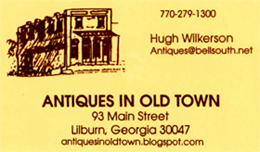
Contact
us to
place your antique
shop
or antique
related
information
here.
|
|
|
|
|

|
|
In Germany in 1708, Johann Friedrich Bottger, a chemist
under the supervision of the King of Saxony, discovered the formula for
producing hard paste porcelain while porcelain producers in England, Italy, and
France had to settle for bone china or soft paste porcelain. The newly found
formula was well guarded for another 60 years until word finally leaked out as
workers left the German factory and took the formula for the process with them.
With the formula now known, the porcelain industry was forever changed.
The
first porcelain factory in France began production in 1771 in the Limousin
region, about 250 miles southwest of Paris. By the 19th century, there were
approximately 32 porcelain production factories and 62 decorating studios. By
the 1920s, there were more than 48 factories and 400-plus known factory marks
identifying pieces of Limoges porcelain, including Tresse-mann and Vogt
(T&V), William Guerin (W.G. & Co.), Jean Pouyat (J.P.L.), and Haviland.
Limoges has ultimately become the generic name for all of the porcelain
produced in the factories in this region. Each factory used a unique factory
back stamp or underglaze mark. Each piece of Limoges was produced using the same
formula of feldspar, kaolin and quartz. Also, each piece was subjected to the
same intense firing process of about 900 degrees for 16 hours, followed by the
glazing process, and yet another firing at approximately 2,000 degrees
Fahrenheit for eight more hours.
Two factors make a piece of Limoges unique:
the different blanks (the shape of the piece of porcelain) and the decorating
process. When the white ware was ready for decoration, there were several
options: the blank was sent to the decorating studio within the factory, sent to
another decorating studio within the region, exported to one of the professional
decorating factories in the United States, or shipped to department stores or
china painting schools for an amateur artist of the era to purchase and hand
paint.
Some of the most desired pieces of Limoges are those that were
factory decorated and signed by a French factory artist. These pieces would have
an underglaze factory mark, an overglaze decorating studio mark, and the
artist's signature in plain view. Each artist's signature is unique, and each
artist specialized in a specific subject matter. For example, a piece hand
painted by the artist Luc is usually far less detailed than a piece hand painted
by the artist Dubois. An unusual blank or a complete set hand painted and signed
by a talented and desired artist has proven to be an excellent investment
today.
Far more common is the factory decorating process known as
"decalcomania", which is a decal or transfer ware. This is the process where an
engraved transfer, like a decal, was placed under the glaze and then fired.
There are also many pieces that were decorated using the transfer ware process
and then enhanced by a factory artist who hand painted and filled in some of the
transferred decoration. Additionally, many pieces with transfer ware decoration
were embellished with hand painted gold details on the edges, handles and feet.
This form of decoration is correctly called "mixtion". The transfer ware and
mixtion processes made the decoration more durable and were used mainly on
dinnerware sets and pieces used in some part of the dining ritual, such as
platters, serving pieces, compotes, etc.
Most collectors in the United
States associate Limoges with the Haviland factories and the very familiar
Haviland dinnerware sets that many of us were lucky enough to inherit or have
passed down in our families. Due to the strict decorating standards set by
Theodore Haviland, most dinnerware sets produced by the Haviland Factory were
also decorated in one of their studios. A piece of Haviland dinnerware will have
an underglaze factory mark and an overglaze factory decorating mark.
Approximately 18,000 barrels of Limoges porcelain were exported to the
United States from the late 19th century well into the 20th century. Because of
this vast number of dinnerware sets and the fact that our society no longer has
sit down dinners for eight to twelve people, the price of most dinnerware is at
an all time low. Of course, there is always the exception-a complete set of
cobalt blue dinnerware, if found, runs well into the thousands of dollars.
From the late 19th century to the early 1930s, thousands of blanks were
imported into the United States. These blanks were then decorated either at one
of the professional American decorating studios by an artist in one of the many
art studios, clubs and affiliations across America or by a wealthy amateur
artist in her home. In 1912, in Chicago alone there were 49 known decorating
studios, and by 1916, that number increased to 102. In addition, there were
decorating studios in New York City, Boston, Philadelphia, Cincinnati, Milwaukee
and Detroit. Some of the professional decorating studios found in the Chicago
area were the Edward Donath Studio, Keates Art Studio, LeRoy Art Studio, Luken
Art Studio, Osborne Art Studio, Pickard Studios, Pitkin & Brooks, Stouffer
Company, Whites Art Company, and Yeschek to name a few.
Other companies or
groups that decorated blanks imported from Europe were the American Hand Painted
China Company, Julius H. Brauer Studio, Kay Bee China Works, Dominick Campana
Studio, A. Heidrich Studios, Humboldt Art Studio, International Art Studios,
Parsche Studios, Seidel Studio, and The Pairpoint Studio. Most of these American
studios identified themselves with an overglaze decorating mark on the bottom of
the piece of porcelain, and they decorated thousands of pieces of blank
porcelain imported to the United States from Europe.
Many of the artists
working in the American decorating studios had worked previously in a European
porcelain factory. It was also common practice for American factory artists to
work in several factories during their lifetimes, thus having multiple studio
affiliations. Some of the more well known artists are: Burton, Challinor,
Donath, Jelinek, Keates, Leon, Roy, Schoenig, Vokral and Yeschek.
The peak of
the Limoges production was during Queen Victoria's reign (1837-1901) and the
Victorian Era (1850-1900) when decoration with ostentation and embellishment
were commonplace. Obsessed with the rose, Victorians used Limoges blanks as a
means of combining their passion for china painting with their love of the rose.
By the mid-19th century, one of America's most popular pastimes was china
painting. Many American china painters visited Europe to learn the art of china
painting, and by the beginning of the 20th century, in the United States alone,
there were more than 25,000 artists enjoying the pastime of china painting. This
large number of amateur artists accounts for the wide variation in decoration
among hand painted Limoges pieces.
The majority of American china painters
were women who were considered amateur. What developed was a huge cottage
industry of women artists who were not only passionate about painting, but were
extremely skilled and talented. But due to the social morays of the era, they
were never allowed to achieve professional status.
After learning the art of
china painting, the amateur artists purchased blanks at fine department stores
and studios. They did not discriminate against any of the Limoges factories;
each artist chose and purchased blanks based on individual interest. Blanks may
have been chosen, for example, to fit into a dresser set that she was putting
together. As a result, most dresser sets have a different factory mark on each
piece, despite being painted by the same artist.
Amateur artists are
responsible for most of the hand painted Limoges porcelain found on the American
market today. The underglaze factory mark will be found on the bottom of these
pieces, and elsewhere the artist's signature, initials and date may be found.
However, many amateur artists did not sign or date their porcelain items, so
fabulous pieces of Limoges art are often found without a signature. This lack of
an amateur artist's signature does not affect the value of a piece, based on the
fact that most reach the retail market without any information on the artist.
Sad, except for the fact that a piece of Limoges hand painted by an amateur
American artist is sometimes more desired by collectors than pieces decorated in
the Limoges factories. And, although the exact history of the artist may be
unknown, the price it commands may be high based on the quality of the painting,
and a beautiful piece of Limoges art has found a well deserved resting place in
a collectors home.
Collecting Limoges can be rewarding if one is armed with
information! Since the early 1990s, hundreds of reproduction pieces have
appeared on the market. Of course, the quality of the porcelain and the artistry
is far below the standard of authentic pieces produced in the Limoges factories
in France. These pieces are allegedly marked with a Limoges factory mark and
being sold as "Limoges" or "Limoges China." The most commonly used mark is a
reproduced "T&V Limoges France" mark along with "Limoges China," "ROC," and
"ROC LIMOGES CHINA". ("ROC" stands for Republic of China.)
Reproductions
aside, there are several factors that contribute to the price and desirability
of a piece of Limoges: the factory where it was produced; the mark or marks; the
age; condition; uniqueness of the blank; size; completeness of a set versus a
single piece from a set, quality of the painting; and the artist's signature.
Keep in mind that an amateur artist's signature does not affect the value, but a
French factory listed artist's signature could place your piece of Limoges into
an investment quality status.
Based on the fact that Limoges is a fine hard
paste porcelain that does not crackle and craze, a piece will be as beautiful
and as useful as it was when it departed the factory in France well over a
hundred years ago. And while keeping in mind that one should collect only what
you love, collecting quality decorative pieces of Limoges can prove to be
rewarding and a great investment today!
Debby DuBay is a
Vietnam and Desert Storm Era Veteran and a retired US Air Force Mustang who
turned her passion for porcelain into a second profession when she opened her
Limoges Antiques Shop 11 years ago (www.limogesantiques.com) in Andover, Mass.
Considered an expert in porcelains, European and American, Ms. DuBay is a USPAP
Appraiser and member of the Appraisers Association of America with an
undergraduate degree and MBA. Ms. DuBay contributes to the updating of porcelain
guides such as The Encyclopedia of Limoges and The Antique Trader Porcelain
Guide and has authored four books: Living With Limoges, Antique Limoges at Home,
and Collecting Hand Painted Limoges Porcelain Boxes to Vases. Her website is
www.collectinglimoges.com
|
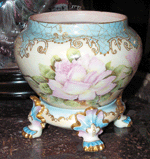
Lovely large hand painted
jardiniere on base,
ca. 1890-1907,
$2,500.

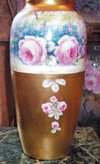
Splendid large
hand painted vase.
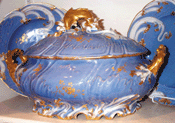
Rare blue soup tureen with Victorian-design
handles and dolphin finial;
with 12 matching soup bowls, W.G. & Co. France, ca. 1891-1900, $3,600.
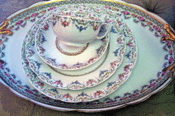
18,000 barrels per month of dinnerware were imported
from 1880 to 1911.
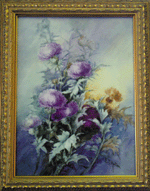
Limoges did not produce tiles, but did make square pieces of
porcelain.
This large 10" x 12" piece by an amateur artist from the T&V factory, ca.,
1907, is valued at $1,200.

Pieces come in all shapes
and sizes and were
decorated by the factory or
by one of
the 25,000 amateur artists
of the era.
|